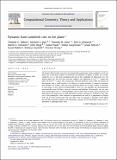Dynamic ham-sandwich cuts in the plane
Author(s)
Abbott, Timothy G.; Burr, Michael A.; Chan, Timothy M.; Demaine, Erik D.; Demaine, Martin L.; Hugg, John; Kane, Daniel; Langerman, Stefan; Nelson, Jelani; Rafalin, Eynat; Seyboth, Kathryn; Yeung, Vincent; ... Show more Show less
DownloadAbbott-2009-Dynamic ham-sandwich.pdf (371.0Kb)
PUBLISHER_POLICY
Publisher Policy
Article is made available in accordance with the publisher's policy and may be subject to US copyright law. Please refer to the publisher's site for terms of use.
Terms of use
Metadata
Show full item recordAbstract
We design efficient data structures for dynamically maintaining a ham-sandwich cut of two point sets in the plane subject to insertions and deletions of points in either set. A ham-sandwich cut is a line that simultaneously bisects the cardinality of both point sets. For general point sets, our first data structure supports each operation in O(n[1 over 3]+ε) amortized time and O(n[4 over 3]+ε) space. Our second data structure performs faster when each point set decomposes into a small number k of subsets in convex position: it supports insertions and deletions in O(logn) time and ham-sandwich queries in O(klog4n)O(klog4n) time. In addition, if each point set has convex peeling depth k, then we can maintain the decomposition automatically using O(klogn) time per insertion and deletion. Alternatively, we can view each convex point set as a convex polygon, and we show how to find a ham-sandwich cut that bisects the total areas or total perimeters of these polygons in O(klog[superscript 4]n) time plus the O((kb)polylog(kb)) time required to approximate the root of a polynomial of degree O(k) up to b bits of precision. We also show how to maintain a partition of the plane by two lines into four regions each containing a quarter of the total point count, area, or perimeter in polylogarithmic time.
Date issued
2009-01Department
Massachusetts Institute of Technology. Computer Science and Artificial Intelligence Laboratory; Massachusetts Institute of Technology. Department of Electrical Engineering and Computer ScienceJournal
Computational Geometry
Publisher
Elsevier
Citation
Abbott, Timothy G., Michael A. Burr, Timothy M. Chan, Erik D. Demaine, Martin L. Demaine, John Hugg, Daniel Kane, et al. “Dynamic Ham-Sandwich Cuts in the Plane.” Computational Geometry 42, no. 5 (July 2009): 419–428. © 2009 Elsevier B.V.
Version: Final published version
ISSN
09257721